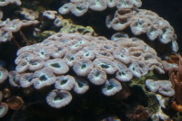Difference between revisions of "Caulastrea furcata"
From The Aquarium Wiki
m (→External links) |
|||
| Line 38: | Line 38: | ||
*[http://www.aquahobby.com/corals/e_Caulastrea_furcata.php Aqua Hobby] | *[http://www.aquahobby.com/corals/e_Caulastrea_furcata.php Aqua Hobby] | ||
*[http://www.peteducation.com/article.cfm?cls=16&cat=1928&articleid=2324 Pet Education] | *[http://www.peteducation.com/article.cfm?cls=16&cat=1928&articleid=2324 Pet Education] | ||
| + | *[https://aquariumdepot.com/corals/lps-corals/ AquariumDepot] | ||
| + | *[https://www.youtube.com/watch?v=gTqwtvOsqbk AquariumDepot.com Video of LPS Corals] | ||
[[Category:Coral (Saltwater)]] | [[Category:Coral (Saltwater)]] | ||
[[Category:Coral (LPS)]] | [[Category:Coral (LPS)]] | ||
Revision as of 10:04, 3 November 2018
Contents
Alternative names
- Blue Spruce Caulastrea, Bullseye Coral, Candy Coral, Candycane Coral, Trumpet Coral
Tank compatibility
- A peaceful coral, should not be kept with any fish or invertebrates that may nip at it, nor near any other corals that may sting it with their sweeping tentacles.
Diet
- This coral benefits from the addition of calcium, strontium, and other trace elements as well as supplemental feedings of foods such as brine shrimp and zooplankton.
Feeding regime
- Supplement food should be fed weekly.
Environment Specifics
- This coral should be placed with plenty of space around it to allow for growth. Their position in the aquarium should be according to the lighting, they are fairly hardy to a variety of light levels. With metal halides keep them in a mid to low position, any other lighting should be mid to high. Water movement should be kept to a medium level.
Identification
- The skeletal structure consists of tubular stalks with stars on each tip. The plump circular polyps are vibrant green, yellow, or blue, and each tip is white. Under actinic light its colourful polyps will stand out from most other corals.
